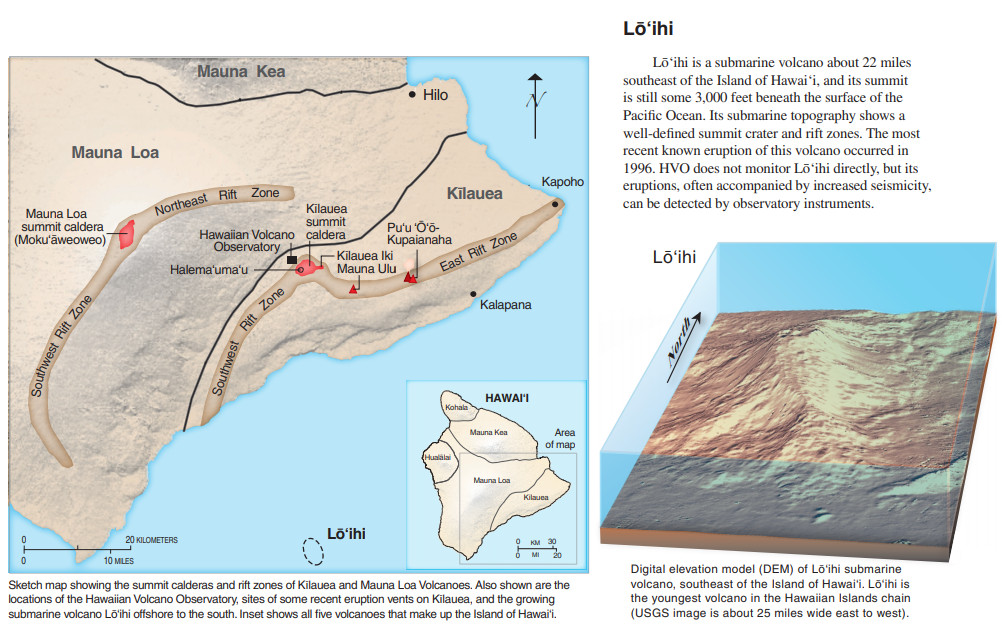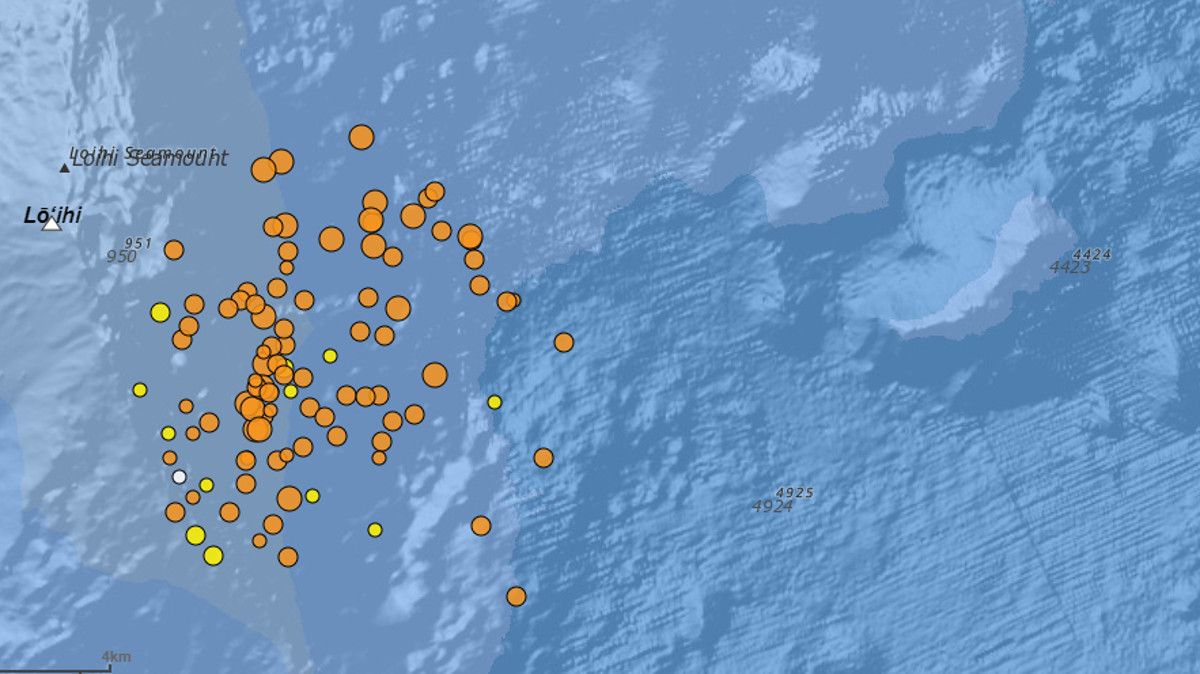
Image from USGS publication “The Story of the Hawaiian Volcano Observatory – A Remarkable First 100 Years of Tracking Eruptions and Earthquakes” available at https://pubs.usgs.gov/gip/135/.
(BIVN) – Following yesterday’s reported uptick in seismicity near Lōʻihi, the active submarine volcano southeast of Hawaiʻi island, the USGS Hawaiian Volcano Observatory issued the following information statement:
SUMMARY
Earthquake activity increased Sunday and Monday in the vicinity of Lōʻihi seamount, the youngest Hawaiian volcano located approximately 35 km (21.7 mi) southeast of Pāhala, at a water depth of ~1 km (~3300 ft) below sea level. There is no indication that a submarine eruption has occurred and there are no significant hazards of concern to the Island of Hawaiʻi at this time.
OBSERVATIONS
Beginning about 3:00 a.m. HST on May 11, 2020 and continuing through the morning of May 12, HVO detected more than 100 earthquakes beneath Lōʻihi, including 79 magnitude-2 (M2) and 19 magnitude-3 (M3) and above. This is a significant increase above long term background rates of fewer than 3 earthquakes per day at Lōʻihi, generally with magnitudes less than 2 . The number of earthquakes peaked at 14 per hour between 1 and 2 pm on Monday afternoon and decreased thereafter. Since the early morning hours of March 12, earthquake rates have been less than 4 per hour.
The earthquake swarm is located beneath the southeast rift zone and southeastern flank of Lōʻihi at depths of 3.6 to 12.4 km (2.2 to 7.7 mi) below sea level or approximately 1 to 9.8 km (0.6 to 6 mi) below the volcano’s surface.
INTERPRETATION AND HAZARD
This swarm may represent a brief magmatic intrusion or movement of magmatic fluids within the volcanic edifice . Although the swarm appears to have diminished in intensity, if earthquakes become shallower, it could lead to the beginning of a submarine eruption, similar to what occurred in 1996.
An eruption of Lōʻihi, if it were to occur, may cause partial draining of its summit magma chamber and summit collapse, as happened in 1996. Significant, sudden changes to the volcano’s surface could displace large volumes of ocean water, which, if large enough, might generate very small local tsunami waves . Earthquakes of magnitude 4 and above could occur if the swarm were to intensify and these may be felt on the Island of Hawaiʻi.
If an eruption or stronger earthquakes occur, very small tsunami waves may affect southeast shores of the Island of Hawaiʻi. Relatively low-energy, steam- and gas-driven explosions can occur at the depth of Lōʻihi, but with limited local effects on the volcano and surrounding ocean water.
There is no direct relationship between the current Lōʻihi swarm and the ongoing increased seismicity observed in Pāhala over the past year. The Lōʻihi swarm is ~35 km (21.7 mi) southeast of Pāhala, at significantly shallower depths. The current Lōʻihi swarm is also unrelated to seismicity observed on the south flank of Kīlauea.
BACKGROUND
LOIHI seamount is an active volcano on the seafloor south of Kīlauea Volcano, about 30 km (19 miles) from the shoreline of the Island of Hawaiʻi. The top of the seamount is about 975 m (3,199 feet ) below sea level. The volcano consists of a broad summit area marked by three pit craters and two prominent rift zones extending from the summit about 22 km (13.6 mi) south-southeast and about 15 km (9.3 mi) north-northeast. The volcano likely has a shallow magma chamber between 1 to 2.5 km (0.6 to 1.6 mi) deep below the summit.
Earthquake activity has been recorded near Lōʻihi since 1952. Prior Lōʻihi earthquake swarms occurred in 1952, 1971–72, 1975, 1986, 1988, 1990, 1991, 1996, 2005, and 2017, and were characterized by hundreds to thousands of earthquakes occurring over weeks to months with magnitudes ranging up to M4.9.
The largest earthquake detected at Lōʻihi was a M5.1 in May of 2005. Many of the 1952 Lōʻihi earthquakes were felt in coastal communities and one of the earthquakes generated a small tsunami that swept inland about 180 m (600 ft) at Kalapana; no damage was reported. The 1996 Lōʻihi earthquake swarm was one of the most intense earthquake swarms recorded by the HVO monitoring networks and is summarized below.
For the six weeks commencing July 16, 1996, HVO recorded more than 4,000 earthquakes in the LOIHI area. Ninety-five of these earthquakes were between magnitude-4.0 and 4.9, and nearly 400 were stronger than magnitude-3. Most of the earthquakes occurred during the last half of July during three time periods, each lasting about two to five days and separated by less than one to four days. Subsequent undersea expeditions to the area discovered that the volcano’s summit area had collapsed to form a new crater about 1,800 ft across and 900 ft deep. Hydrothermal vents were observed in the new the crater, and evidence was found of newly erupted lava. For more information, see the University of Hawaii, School of Ocean and Earth Science and Technology, Web site.
HVO continues to closely monitor the earthquake activity in the Lōʻihi area and will issue further updates as needed. There are no monitoring instruments on LOIHI seamount, thus earthquake locations are not as accurate as those on the Island of Hawaiʻi. Significant changes in activity at Lōʻihi, Mauna Loa, and Kīlauea Volcano will be reported through the USGS Volcano Notification System and the HVO Web site. We are in frequent communication with Hawai‘i Volcanoes National Park and Hawai‘i County Civil Defense to keep them apprised of the activity.


by Big Island Video News2:04 pm
on at
STORY SUMMARY
HAWAIʻI ISLAND - The Hawaiian Volcano Observatory on Tuesday posted a statement on the increased earthquake activity near the Lōʻihi seamount.